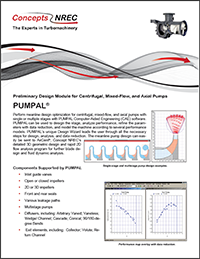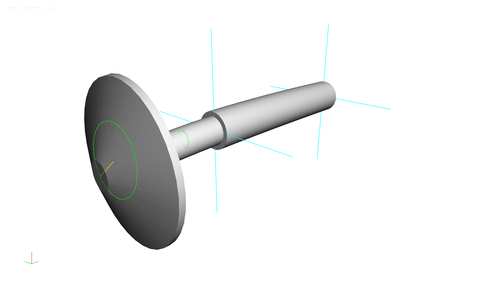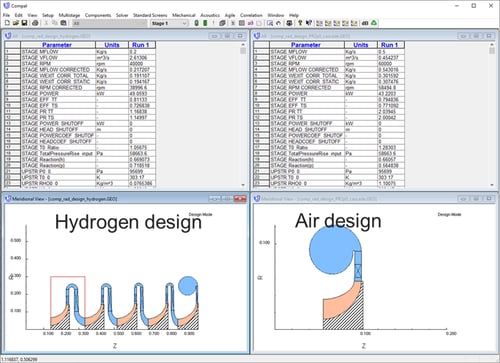PUMPAL®
CAE Software for Axial and Radial Pumps
A meanline approach is used to design centrifugal pumps and mixed-flow pumps with single and multiple stages. PUMPAL® is used to design the stage, analyze performance, refine the parameters with data reduction, and model the machine according to several performance models. PUMPAL's unique Design Wizard leads the user through all the necessary steps for design, analysis, and data reduction. The meanline pump design can easily be sent to the AxCent®program for further blade design and fluid dynamic analysis.
Components Supported by PUMPAL:
- Inlet guide vanes
- Open or closed impellers
- 2D or 3D impellers
- Front and rear seals (multiple)
- Diffuser types, including…
- Arbitrary vaned
- Vaneless
- Wedge/channel
- Cascade
- Conical
- 90/180 degree bends
- Exit elements, including…
- Collector
- Volute
- Return channel
- Various leakage paths
- Multistage pumps
Modeling
PUMPAL supports two-elements-in-series (TEIS) rotor diffusion modeling, two-zone loss modeling, radial and axial stator diffusion/losses, volutes, inlet cavitation, disk friction, exit mixing, cavity leakage, and more. PUMPAL uses the same consistent model of the stage performance for design, analysis, and data reduction modes.
Integrated Performance Map Plotting
Review design performance, analysis, and test data with flexibly plotted performance maps, updated automatically with each geometric change.
Easy Editing
View the pump stage in an active, true-scale meridional view. Edit the parameters by double clicking on the component in the meridional view. Parameters can also be edited using a single text input/output file, a feature especially useful for optimization.
Tabular View of Results
View the results in a flexible, spreadsheet-like table format, customizable through separate filters. Create any number of filters, select what to display, and customize the labels as well.
Axial View with Inlet and Exit Velocity Triangles
Using the window view, view blades and velocity triangles at the impeller inlet and exit. View inlet velocity triangles for the hub, tip, or RMS radius, and exit velocity triangles for the primary and secondary zones, and mixed-out state.
A Real Fluid Program
PUMPAL calculates Real Fluid properties using a variety of equations of state options.
Direct Integration with AxCent®
Start AxCent automatically from PUMPAL, with the initial meanline geometry transferred automatically to AxCent. Changes in AxCent that affect the meanline analysis will cause the meanline analysis to be rerun and all performance maps to be regenerated.

Software Highlights
2020 Release Features
Components Supported by PUMPAL
- Inlet guide vanes
- Open or closed impellers
- 2D or 3D impellers
- Front and rear seals (multiple)
- Diffuser types, including…
- Arbitrary vaned
- Vaneless
- Wedge/channel
- Cascade
- Conical
- 90/180 degree bends
- Exit elements, including…
- Collector
- Volute
- Return channel
- Various leakage paths
- Multistage pumps
Modeling
PUMPAL supports two-elements-in-series (TEIS) rotor diffusion modeling, two-zone loss modeling, radial and axial stator diffusion/losses, volutes, inlet cavitation, disk friction, exit mixing, cavity leakage, and more. PUMPAL uses the same consistent model of the stage performance for design, analysis, and data reduction modes.
Integrated Performance Map Plotting
Review design performance, analysis, and test data with flexibly plotted performance maps, updated automatically with each geometric change.
Easy Editing
View the pump stage in an active, true-scale meridional view. Edit the parameters by double clicking on the component in the meridional view. Parameters can also be edited using a single text input/output file, a feature especially useful for optimization.
Tabular View of Results
View the results in a flexible, spreadsheet-like table format, customizable through separate filters. Create any number of filters, select what to display, and customize the labels as well.
Axial View with Inlet and Exit Velocity Triangles
Using the window view, view blades and velocity triangles at the impeller inlet and exit. View inlet velocity triangles for the hub, tip, or RMS radius, and exit velocity triangles for the primary and secondary zones, and mixed-out state.
A Real Fluid Program
PUMPAL calculates Real Fluid properties using a variety of equations of state options.
Direct Integration with AxCent
Start AxCent automatically from PUMPAL, with the initial meanline geometry transferred automatically to AxCent. Changes in AxCent that affect the meanline analysis will cause the meanline analysis to be rerun and all performance maps to be regenerated.
Product Support

Customer-driven Improvement

Technical Support

Documentation
PUMPAL Brochure
Perform meanline design optimization for centrifugal, mixed-flow, and axial pumps with
single or multiple stages. PUMPAL can be used to design the stage, analyze performance, refine the parameters with data reduction, and model the machine according to several performance
models.

Find Your Rep
Our Sales Offices are strategically located around the globe to service all your turbomachinery needs.
Corporate Headquarters
217 Billings Farm Road
White River Junction, VT 05001-9486
Phone: 802-296-2321
Fax: 802-296-2325
Email: sales@conceptsnrec.com
North America Software Sales
Phone: 802-280-6181
Fax: 802-296-2325
Email: droberson@conceptsnrec.com
Upcoming Events
Tradeshows, Workshops, Webinars and more.
2021 Online Centrifugal and Axial Pumps Course - Modern Design, Performance, and Problem Solving
Application-Based Learning
Date: October 18 - 29, 2021
Time: 9:30 am - 1:00 pm EDT
Course Fee: $3500 USD
This course is designed to help engineers design, test, and run pumps and systems that are more efficient, more economical, and more reliable. Engineers will come to understand the best state-of-the-art design practices and learn the latest theories on performance, cavitation, dynamic forces, and noise. The course will review the latest advances in design tools and will provide expert and relevant instruction to designers on pump design optimization. Nearly half of all the teaching is focused on actual commercial design cases with measured data for confirmation.
2021 Trade Show: ComVac Asia
Visit Concepts NREC China at the ComVac Asia
Date: October 26-29, 2021
Location: Shanghai, China
To learn more, visit https://www.comvac-asia.com/index.php?lang=en
I came to the realization that we needed some objective insight.
We were working well with the OEM but even with our combined efforts, we were struggling to get a critical compressor to pass performance on their test stand. Although I'd never directly done business with Concepts NREC I was familiar with them and their capability so I chose to contact them when I came to the realization that we needed some objective insight. Concepts NREC fielded my cold call and immediately engaged their expertise in a complex problem that was also challenged by schedule constraints. They provided increased understanding of an already complex CFD which resulted in increased confidence that the proposed solution would succeed on the next test stand attempt (which it did!). We are pleased to have had the help of Concepts NREC and now have a well-performing compressor in our process.”
Bryan Barrington
Senior Advisor - Machinery Engineering




